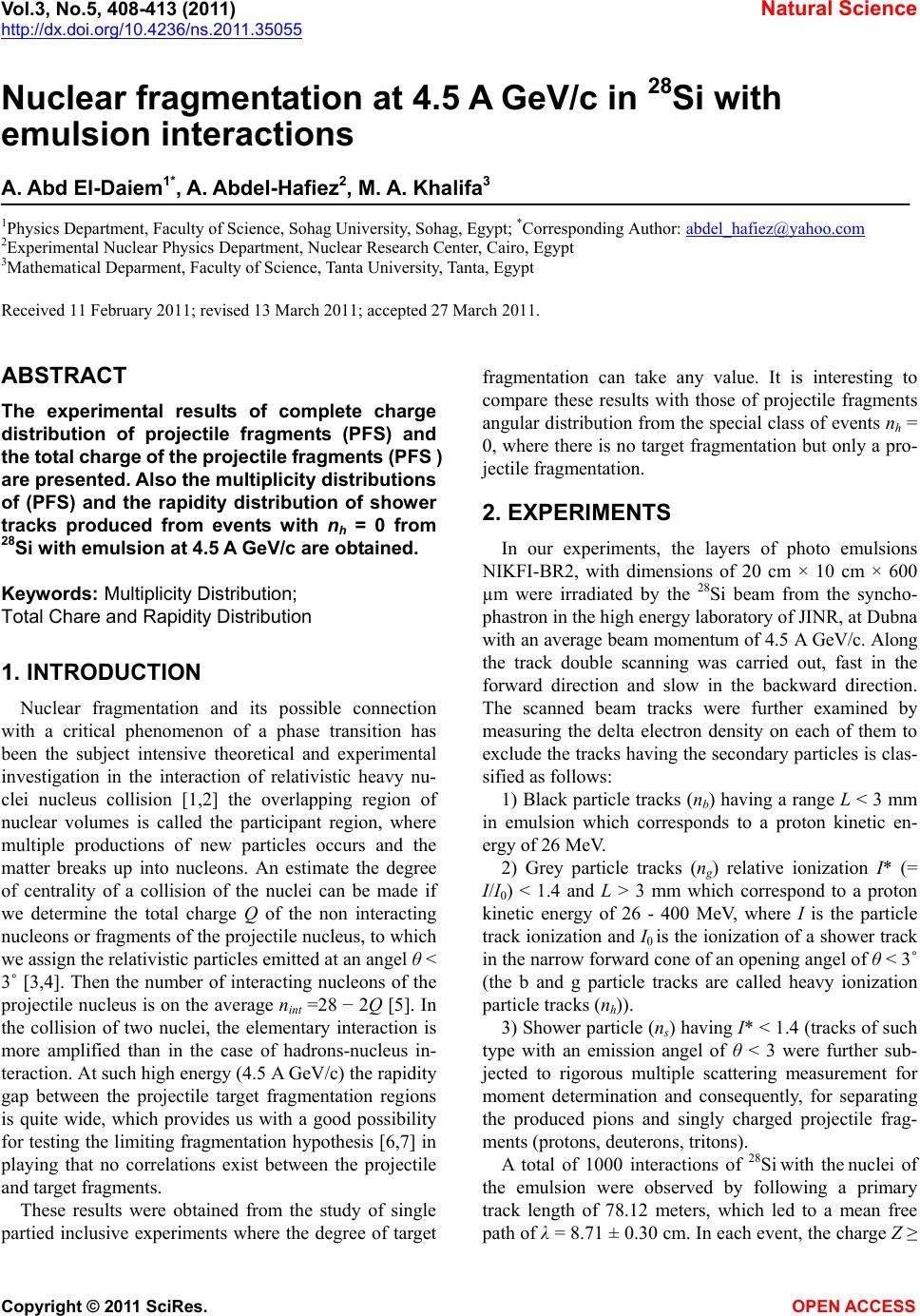
Vol.3, No.5, 408-413 (2011) Natural Science
http://dx.doi.org/10.4236/ns.2011.35055
Copyright © 2011 SciRes. OPEN ACCESS
Nuclear fragmentation at 4.5 A GeV/c in 28Si with
emulsion interactions
A. Abd El-Daiem1*, A. Abdel-Hafiez2, M. A. Khalifa3
1Physics Department, Faculty of Science, Sohag University, Sohag, Egypt; *Corresponding Author: abdel_hafiez@yahoo.com
2Experimental Nuclear Physics Department, Nuclear Research Center, Cairo, Egypt
3Mathematical Deparment, Faculty of Science, Tanta University, Tanta, Egypt
Received 11 February 2011; revised 13 March 2011; accepted 27 March 2011.
ABSTRACT
The experimental results of complete charge
distribution of projectile fragments (PFS) and
the total charge of the projectile fragments (PFS )
are presented. Also the multiplicity distributions
of (PFS) and the rapidity distribution of shower
tracks produced from events with nh = 0 from
28Si with emulsion at 4.5 A GeV/c are obtained.
Keywords: Multiplicity Distribution;
Total Chare and Rapidity Distribution
1. INTRODUCTION
Nuclear fragmentation and its possible connection
with a critical phenomenon of a phase transition has
been the subject intensive theoretical and experimental
investigation in the interaction of relativistic heavy nu-
clei nucleus collision [1,2] the overlapping region of
nuclear volumes is called the participant region, where
multiple productions of new particles occurs and the
matter breaks up into nucleons. An estimate the degree
of centrality of a collision of the nuclei can be made if
we determine the total charge Q of the non interacting
nucleons or fragments of the projectile nucleus, to which
we assign the relativistic particles emitted at an angel θ <
3˚ [3,4]. Then the number of interacting nucleons of the
projectile nucleus is on the average nint =28 − 2Q [5]. In
the collision of two nuclei, the elementary interaction is
more amplified than in the case of hadrons-nucleus in-
teraction. At such high energy (4.5 A GeV/c) the rapidity
gap between the projectile target fragmentation regions
is quite wide, which provides us with a good possibility
for testing the limiting fragmentation hypothesis [6,7] in
playing that no correlations exist between the projectile
and target fragments.
These results were obtained from the study of single
partied inclusive experiments where the degree of target
fragmentation can take any value. It is interesting to
compare these results with those of projectile fragments
angular distribution from the special class of events nh =
0, where there is no target fragmentation but only a pro-
jectile fragmentation.
2. EXPERIMENTS
In our experiments, the layers of photo emulsions
NIKFI-BR2, with dimensions of 20 cm × 10 cm × 600
µm were irradiated by the 28Si beam from the syncho-
phastron in the high energy laboratory of JINR, at Dubna
with an average beam momentum of 4.5 A GeV/c. Along
the track double scanning was carried out, fast in the
forward direction and slow in the backward direction.
The scanned beam tracks were further examined by
measuring the delta electron density on each of them to
exclude the tracks having the secondary particles is clas-
sified as follows:
1) Black particle tracks (nb) having a range L < 3 mm
in emulsion which corresponds to a proton kinetic en-
ergy of 26 MeV.
2) Grey particle tracks (ng) relative ionization I* (=
I/I0) < 1.4 and L > 3 mm which correspond to a proton
kinetic energy of 26 - 400 MeV, where I is the particle
track ionization and I0 is the ionization of a shower track
in the narrow forward cone of an opening angel of θ < 3˚
(the b and g particle tracks are called heavy ionization
particle tracks (nh)).
3) Shower particle (ns) having I* < 1.4 (tracks of such
type with an emission angel of θ < 3 were further sub-
jected to rigorous multiple scattering measurement for
moment determination and consequently, for separating
the produced pions and singly charged projectile frag-
ments (protons, deuterons, tritons).
A total of 1000 interactions of 28Si with the nuclei of
the emulsion were observed by following a primary
track length of 78.12 meters, which led to a mean free
path of λ = 8.71 ± 0.30 cm. In each event, the charge Z ≥